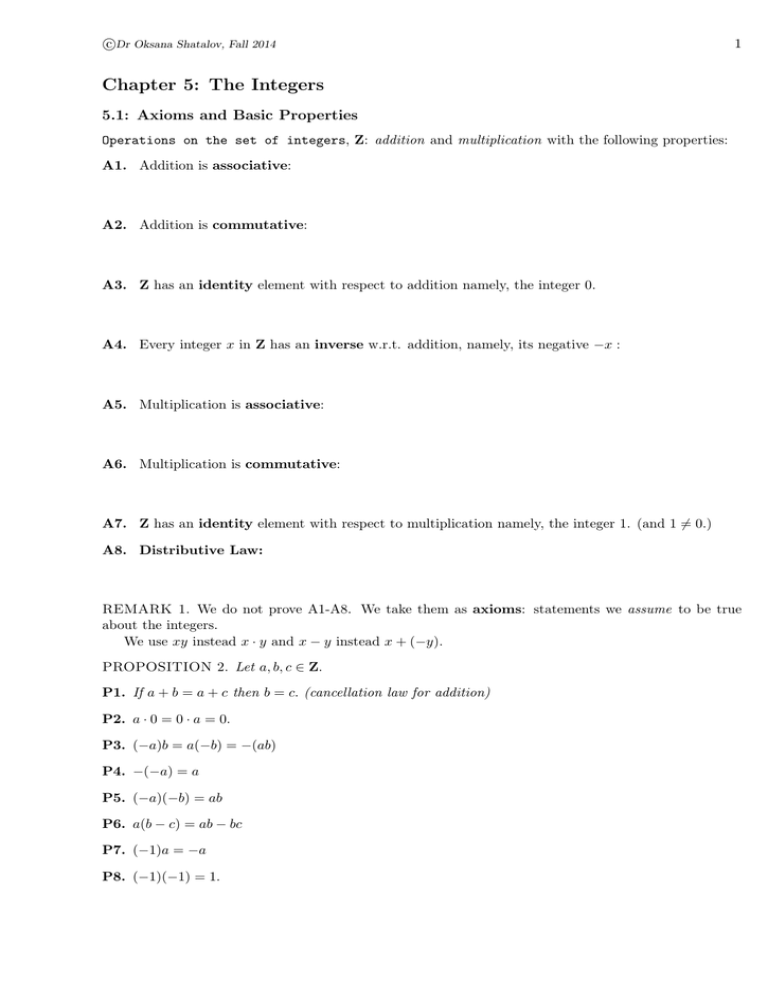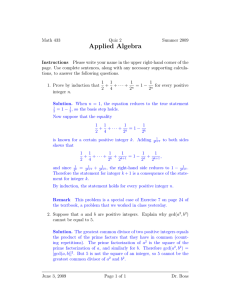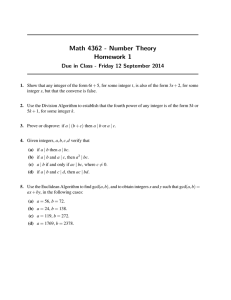Document 10581896
advertisement

c Dr Oksana Shatalov, Fall 2014
1
Chapter 5: The Integers
5.1: Axioms and Basic Properties
Operations on the set of integers, Z: addition and multiplication with the following properties:
A1. Addition is associative:
A2. Addition is commutative:
A3. Z has an identity element with respect to addition namely, the integer 0.
A4. Every integer x in Z has an inverse w.r.t. addition, namely, its negative −x :
A5. Multiplication is associative:
A6. Multiplication is commutative:
A7. Z has an identity element with respect to multiplication namely, the integer 1. (and 1 6= 0.)
A8. Distributive Law:
REMARK 1. We do not prove A1-A8. We take them as axioms: statements we assume to be true
about the integers.
We use xy instead x · y and x − y instead x + (−y).
PROPOSITION 2. Let a, b, c ∈ Z.
P1. If a + b = a + c then b = c. (cancellation law for addition)
P2. a · 0 = 0 · a = 0.
P3. (−a)b = a(−b) = −(ab)
P4. −(−a) = a
P5. (−a)(−b) = ab
P6. a(b − c) = ab − bc
P7. (−1)a = −a
P8. (−1)(−1) = 1.
c Dr Oksana Shatalov, Fall 2014
Proof
Z contains a subset Z+ , called the positive integers, that has the following properties:
A9. Closure property: Z+ is closed w.r.t. addition and multiplication:
A10. Trichotomy Law: for all x ∈ Z exactly one is true:
PROPOSITION 3. If x ∈ Z, x 6= 0, then x2 ∈ Z+ .
Proof.
COROLLARY 4. Z+ = {1, 2, 3, . . . , n, n + 1, . . .}
Proof.
2
c Dr Oksana Shatalov, Fall 2014
3
Inequalities (the order relation less than)
DEFINITION 5. For x, y ∈ Z, x < y if and only y − x ∈ Z+ .
Note that Z+ = {n ∈ Z|n > 0} .
PROPOSITION 6. For all a, b ∈ Z:
Q1. Exactly one of the following holds: a < b, b < a, or a = b.
Q2. If a > 0 then −a < 0; if a < 0 then −a > 0.
Q3. If a > 0 and b > 0 then a + b > 0 and ab > 0.
Q4. If a < 0 and b < 0 then a + b < 0 and ab > 0.
Proof.
A11. The Well Ordering Principle Every nonempty subset on Z+ has a smallest element; that is,
if S is a nonempty subset of Z + , then there exists a ∈ S such that a ≤ x for all x ∈ S.
PROPOSITION 7. There is no integer x such that 0 < x < 1.
Proof.
c Dr Oksana Shatalov, Fall 2014
4
COROLLARY 8. 1 is the smallest element of Z+ .
COROLLARY 9. The only integers having multiplicative inverses in Z are ±1.
Proof.
5.2: Induction
THEOREM 10. (First Principle of Mathematical Induction) Let P (n) be a statement about the
positive integer n. Suppose that P (1) is true. Whenever k is a positive integer for which P (k) is true,
then P (k + 1) is true. Then P (n) is true for every positive integer n.
Proof.
c Dr Oksana Shatalov, Fall 2014
5
Strategy
The proof by induction consists of three steps:
Basic Step. Verify that P (1) is true.
Induction hypothesis. Assume that P (k) is true.
Inductive Step. With the assumption made, prove that P (k + 1) is true.
EXAMPLE 11. Prove by induction the formula for the sum of the first n positive integers
1 + 2 + 3 + ... + n =
n(n + 1)
.
2
EXAMPLE 12. Prove by induction the formula for the sum of the first 2n + 1 odd numbers.
(1)
c Dr Oksana Shatalov, Fall 2014
6
EXAMPLE 13. Prove by induction the following formula
12 + 2 2 + 3 2 + . . . + n2 =
n(n + 1)(2n + 1)
6
Paradox: All horses are of the same color.
Question: What’s wrong in the following “proof” of G. Pólya?
Basic Step. If there is only one horse, there is only one color.
Inductive step. Assume as induction hypothesis that within any set of n horses, there is
only one color. Now look at any set of k +1 horses. Number them: 1, 2, 3, ..., k, k +1. Consider
the sets {1, 2, 3, ..., k} and {2, 3, 4, ..., k + 1}. Each is a set of only n horses, therefore within
each there is only one color. But the two sets overlap, so there must be only one color among
all k + 1 horses.
c Dr Oksana Shatalov, Fall 2014
7
5.3: The Division Algorithm And Greatest Common Divisor
Recall
A11. The Well Ordering Principle Every nonempty subset on Z+ has a smallest element; that is,
if S is a nonempty subset of Z + , then there exists a ∈ S such that a ≤ x for all x ∈ S.
THEOREM 14. (Division Algorithm) Let a ∈ Z, b ∈ Z+ . Then there exist unique integers q and r
such that
a = bq + r, where 0 ≤ r < b.
Proof.
c Dr Oksana Shatalov, Fall 2014
8
Divisors
DEFINITION 15. Let a and b be integers. We say that b divides a, written b|a, if there is an integer
c such that bc = a. We say that b and c are factors of a, or that a is divisible by b and c.
For example,
EXAMPLE 16. Prove that 3|4n − 1, where n ∈ Z+ .
Greatest common divisor (gcd)
DEFINITION 17. Let a and b be integers, not both zero. The greatest common divisor of a and b
(written gcd(a, b), or (a, b)) is the largest positive integer d that divides both a and b.
EXAMPLE 18. Find gcd(18, 24).
c Dr Oksana Shatalov, Fall 2014
9
Euclidean Algorithm
is based on the following two lemmas:
LEMMA 19. Let a and b be integers. If a|b then gcd(a, b) = a.
LEMMA 20. Let a and b be two positive integers such that b ≥ a. Then gcd(a, b) = gcd(a, b − a).
Proof.
COROLLARY 21. Let a and b be integers, not both zero. Suppose that there exist integers q1 and r1
such that b = aq1 + r1 , 0 ≤ r1 < a. Then gcd(a, b) = gcd(a, r1 ).
Procedure for finding gcd of two integers (the Euclidean Algorithm)
c Dr Oksana Shatalov, Fall 2014
10
EXAMPLE 22. Find gcd(1176, 3087).
EXAMPLE 23. Find integers x and y such that 147 = 1176x + 3087y.
COROLLARY 24. If d = gcd(a, b) then there exist integers x and y such that ax + by = d. Moreover,
d is the minimal natural number with such property.
Relatively prime (or coprime) integers
DEFINITION 25. Two integers a and b, not both zero, are said to be relatively prime (or coprime),
if gcd(a, b) = 1.
For example,
Combining the above definition and the proof of Corollary 24, we obtain
THEOREM 26. a and b are relatively prime integers if and only if there exist integers x and y such
that ax + by = 1.
THEOREM 27. Let a, b, c ∈ Z. Suppose a|bc and gcd(a, b) = 1. Then a|c.
Proof.
c Dr Oksana Shatalov, Fall 2014
11
5.4: Primes and Unique Factorization
DEFINITION 28. An integer p greater than 1 is called a prime number if the only divisors of p are
±1 and ±p. If an integer greater than 1 is not prime, it is called composite.
For example,
Sieve of Eratosthenes.
The method to find all primes from 2 to n.
1. Write out all integers from 2 to n.
2. Select the smallest integer k that is not selected or crossed out.
3. Cross out all multiples of k.
4. If not all numbers are selected or crossed out return to step 2. Otherwise, all selected numbers are
prime.
EXAMPLE 29. Find all two digit prime numbers.
2
22
42
62
82
3
23
43
63
83
4
24
44
64
84
5
25
45
65
85
6
26
46
66
86
7
27
47
67
87
8
28
48
68
88
9
29
49
69
89
10
30
50
70
90
11
31
51
71
91
12
21
32
41
52
61
72
81
92
√
REMARK 30. If the number k in step 2 is greater than n
or not crossed out are prime.
13
33
53
73
93
14
34
54
74
94
15
35
55
75
95
16
36
56
76
96
17
37
57
77
97
18
38
58
78
98
19
39
59
79
99
20
40
60
80
then all numbers that are already selected
Prime Factorization of a positive integer n greater than 1 is a decomposition of n into a product
of primes.
THEOREM 31. Unique Prime Factorization Theorem. Any positive integer n greater than one admits a prime factorization. This factorization is unique up to rearranging of the factors.
EXAMPLE 32. Write 1224 in standard form (i.e. find its prime factorization).
c Dr Oksana Shatalov, Fall 2014
12
LEMMA 33. Let a and b be integers. If p is prime and divides ab, then p divides either a, or b. (Note,
p also may divide both a and b.)
Proof.
COROLLARY 34. Let a1 , a2 , . . . , an be integers.If p is prime and divides a1 a2 · . . . · an , then p divides
at least one integer from a1 , a2 , . . . , an .
Note that Lemma 33 corresponds to n = 2. General proof of the above Corollary is by induction.
THEOREM 35. (Second Principle of Mathematical Induction) Let P (n) be a statement about
the positive integer n. Suppose that P (1) is true. Whenever k is a positive integer for which P (i) is true
for every positive integer i such that i ≤ k, then P (k + 1) is true. Then P (n) is true for every positive
integer n.
THEOREM 36. Unique Prime Factorization Theorem. Any positive integer n greater than one admits a prime factorization. This factorization is unique up to rearranging of the factors.
Proof of the Unique Prime Factorization Theorem.
Existence: Use the Second Principle of Mathematical Induction.
P (n) :
Basic step:
Induction hypothesis:
Case 1: k + 1 is prime
Case 1: k + 1 is composite
c Dr Oksana Shatalov, Fall 2014
Uniqueness Use the Second Principle of Mathematical Induction. P (n) :
Basic step:
Induction hypothesis:
COROLLARY 37. There is infinitely many prime numbers.
Proof.
13
c Dr Oksana Shatalov, Fall 2014
14
EXAMPLE 38. Prove that if a is a positive integer of the form 4n + 3, then at least one prime divisor
of a is of the form 4n + 3.
Proof.






